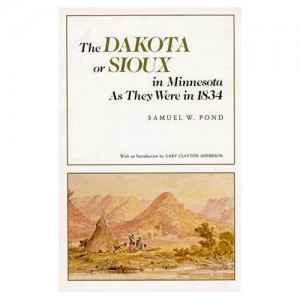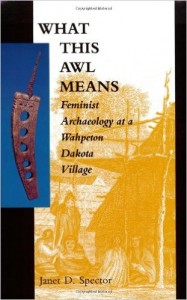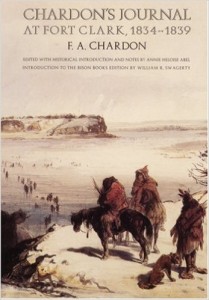Recently, I had a friend who was just getting started in historical reenacting ask about some books to read about the fur trade in Minnesota. I looked at my book shelf and came up with some ideas. Some classic, some basic, some scholarly. Lots of journals AND archaeological reports. I like them!
Below are my top 10 (or so!) recommendations to study up with. Most of these are available at libraries and certainly through inter-library loan. Several are available at various Minnesota Historical Society (MNHS) gift shops. And don’t forget, members get a discount!
#1. The Dakota or Sioux in Minnesota as they were in 1834. Samuel Pond. (Minnesota Historical Society Press, 1986;  reprinted as Dakota Life in the Upper Midwest, Minnesota Historical Society Press, 2002) A reminiscence, but shows a very detailed picture of Dakota culture in our area in the 1830’s. I like it so much, I’ve given copies to friends.
reprinted as Dakota Life in the Upper Midwest, Minnesota Historical Society Press, 2002) A reminiscence, but shows a very detailed picture of Dakota culture in our area in the 1830’s. I like it so much, I’ve given copies to friends.
#2. Red River Trails: Oxcart Routes between St Paul and the Selkirk Settlement 1820-1870. Rhoda Gilman. (Minnesota Historical Society Press, 1979) The first chapter is totally on the Columbia fur company in the 1820’s and it’s pretty good. I like the rest of the book too!! Good overview on Minnesota territorial history and commerce.
#3. Recollections of Philander Prescott, Frontiersman of the Old Northwest, 1819-1862. Philander Prescott. (University of Nebraska Press; 1st edition, 1966) Describes his experience in the early days near Fort Snelling and beyond. Hard to find, but I have found several copies on used book sites.
#4. A Toast to the Fur Trade: A Picture Essay on Its Material Culture. Robert C. Wheeler. (Saint Paul, MN: Wheeler Productions, 1985) Well-illustrated, short chapters on various aspects of the trade, complete with illustrations of actual artifacts found at fur trade era sites such as Grand Portage. It’s a must read!!
OK, that’s a few to get you started. But, if you want to go further and have time for more great reads, here’s more . . .
#5. What This Awl Means: Feminist Archaeology at a Wahpeton Dakota Village. Janet Spector. (Minnesota Historical Society Press; 1993) It can be criticized as a study, but I like it. It personalizes native women’s roles using storytelling and archaeology about a specific awl found at the Little Rapids site, near Carver along the Minnesota River.
Society Press; 1993) It can be criticized as a study, but I like it. It personalizes native women’s roles using storytelling and archaeology about a specific awl found at the Little Rapids site, near Carver along the Minnesota River.
#6. Voices from the Rapids: An Underwater Search for Fur Trade Artifacts, 1960-73. Robert C. Wheeler. (Minnesota Historical Society Press; First Edition, 1975) All about the underwater archaeology done in the boundary waters in the 1960’s. I love archaeological reports!!
#7. Where Two Worlds Meet: The Great Lakes Fur Trade. Carolyn Gilman, editor. (Minnesota Historical Society Press, Saint Paul, 1982) It’s the catalog of an exhibit that MNHS had long ago. Lots of good information, still an interesting read and a useful resource about the upper Great Lakes fur trade. Seeing that exhibit 25 years ago inspired me.
#8. Chardon’s Journal at Fort Clark, 1834-1839. F.A. Chardon. (University of Nebraska Press; 1997) This is a diary, much  like the Tolliver journal. All about 1830’s daily activities at a fur trade post on the Missouri River.
like the Tolliver journal. All about 1830’s daily activities at a fur trade post on the Missouri River.
#9. The Falcon. Daniel Williams Harmon. (Penguin Classics, 2003) Born on the Kentucky River around 1780, Tanner was captured and spent most of his life with the Ojibwe of Lower Canada. It’s a good one, filled with lots of cultural stuff.
#10. Journal of a Trapper or Nine Years Residence among the Rocky Mountains Between the years of 1834 and 1843. Osborne Russell. (Fine Communications; reprint edition, 1997) Another reminiscence. Mountain man stuff. I originally read this in the Wind River Mountains of Wyoming while on a 3 week National Outdoor Leadership School (NOLS) winter camping trip in January 1979. It was inspiring and cool because I was there where it happened. Wagh!!
#11. The Voyageur. Grace Lee Knute. (St. Paul: Minnesota Historical Society Press, 1955, reprinted 1987) It’s dated. Some mistakes, but it’s still a fur trade classic. For many years, this was the definitive work on the French-Canadians who manned the great canoes of the fur trade.
So my basic advice? If you want to learn about the fur trade, learn about anything, read books. Read lots of books. As Mark Twain says, ““The man who does not read good books has no advantage over the man who can’t read.”


I have two books that I would like to donate to your library or
a member. They are; “Five Fur Traders of the Northwest” and
“Many Tender Ties” (Women in Fur-Trade Society, 1670-1870).
Thank you Margaret! We would gladly take them, but we are actually in the process of combining our club library to the North West Company Fur Post in Pine City and will no longer be maintaining an independent collection of books. If you are still interested in donating your books, I recommend contacting the North West Company Fur Post directly about your donation. Their email is nwcfurpost@mnhs.org and our club members will continue to have access to these materials as their library is actually more accessible to membership than our current situation.
Both are great books Margaret. Thanks, Spence